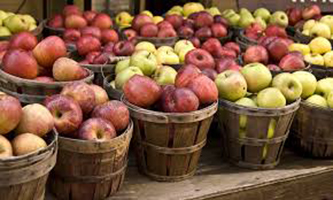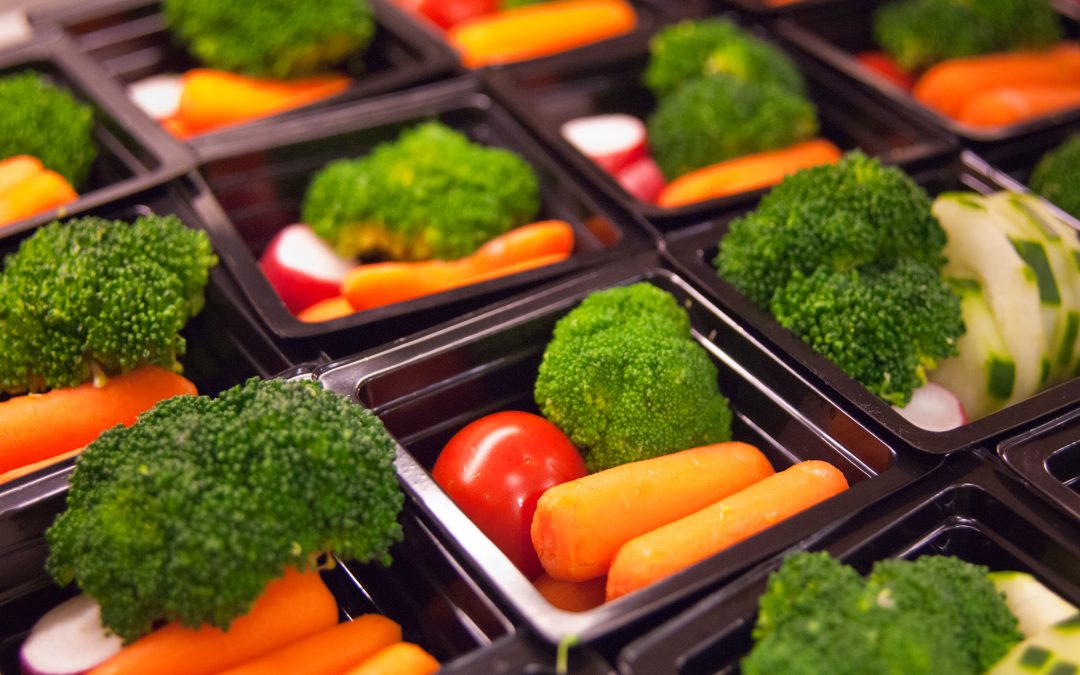by admin | Sep 1, 2018 | Grown Up, Healthy Food, Nutrition, Recipes
As we get ready to kickoff another college football season, we wanted to share a healthy snack idea … Tasty Trail Mix!
Snacking and healthful are two of a kind in this homemade trail mix recipe. As you’re cheering on your favorite football team(s), have this nutritious trail mix ready to go. In this recipe, we use nuts for good fats and dried fruit for vitamins and minerals to give you a sweet, salty and satisfying sideline snack for all you armchair quarterbacks! (more…)

by admin | Oct 26, 2017 | Educator, Healthy Food, Kids, Nutrition
Let’s do an Apple Taste Test for National Apple Month! Apples are also an OrganWise Guys Foods of the Month for October, and the perfect food for the fall season. Apples are such a versatile food that can be used in anything from salads to desserts and they come in so many delicious varieties!
Chew on this interesting apple trivia:
- Americans eat approximately 120 apples apiece each year!
- Apples are nutritious because they contain lots of fiber, vitamins C, B6, and A, and potassium, as well as antioxidants.
- 2500 known varieties are grown in the United States.
- 36 states grow them with Washington, New York, Michigan, California, Pennsylvania, and Virginia being the top production states.
- Apples are available all year round and are a perfect take-along snack anytime!
- Apples don’t require peeling so eat the skin because it contains healthy nutrients.
A taste test is a really fun way to encourage kids to try a small sample of a new food where they may typically be more close-minded about trying new things. This interactive apple taste testing worksheet will help you introduce several different apple varieties and let’s them provide feedback.
We would love to hear about your at-home taste tests! Share with us how it went and include any pictures of the finished worksheets on our Facebook page!

by admin | Sep 30, 2017 | Educator, Healthy Food, Nutrition, Recipes
Did you know that you can substitute whole wheat flour for white flour when baking? What better time that September, when whole grains are a Foods of the Month, to try this out?!
ICYMI, whole wheat is a subset of whole grain that strictly applies to wheat products. So when a product is labeled whole grain, it means that it includes the entire kernel of the grain – including the outer bran layer, the germ (the part that can sprout into a new plant), and the inner, starchy endosperm. Refined grains, on the other hand, only include the endosperm; that’s why whole grains generally take longer to cook.
One of our favorite ways to get more whole grains (organic is best) is by swapping out white flour for whole wheat flour in pizza dough. The great thing about making your own pizza dough is that you can make a big batch and store it in the fridge, to create various healthy dinners throughout the week. To make whole wheat pizza dough, we recommend using half whole wheat flour and half white flour in your favorite pizza dough recipe. By leaving some white flour, the dough is not too dense, but you still get the fiber benefits of whole wheat flour. Combine your flour with yeast, hot water, a little salt and sugar, some extra virgin olive oil and mix thoroughly.
Now, what to do with your healthy homemade pizza dough? Get a little more creative than a regular pizza and try making a calzone or Stromboli! To make these traditionally fatty dishes healthier, spread a thin layer of tomato sauce on the dough, add organic cheese, and then top with tons of veggies like tomatoes, peppers, onions and spinach. Carefully roll it up, and put in the oven at 375 degrees for 35 minutes. Enjoy!

by admin | Mar 7, 2017 | Kids, Nutrition, Uncategorized
We all know the importance of protein to maintain and repair the body, but many new parents worry that their baby or toddler may not be getting enough protein in their early, formative years. Because protein is essential to growth and development, it is critical that little ones get enough of this vital nutrient because they are growing so rapidly. In fact, babies and toddlers need more protein per pound of body weight than older children or even adults.
What exactly is protein and why is it so important? Protein, along with carbohydrates and fats, are three essential nutrients found in food that all of us need. We get protein from certain foods that our bodies then digest into small compounds called amino acids. There are many amino acids but humans use only 22 of them to grow and maintain our bones, muscles, blood, skin, hair and organs. Of the 22 amino acids we humans must have, our bodies can make 13 of them. We have to get the other 9 – called essential amino acids – from protein-rich foods, such as meat, eggs, dairy products and beans.
So what do babies do to get their protein? The good news is that breast milk or formula supplies all the calories and protein a baby needs until they are 4 to 6 months old. Before that time, a baby’s digestive system simply isn’t ready for more than a liquid diet. After 6 months, however, protein-rich solid foods should gradually be introduced to supplement the mother’s breast milk or formula. It is important that babies get protein every day because the body doesn’t store protein the way it stores fat and carbohydrates.
Protein is important for infants because the body weight of a baby doubles by age 6 months – and scientists estimate that about 10 percent of a young child’s energy comes from protein. Skimping on protein can slow down a baby’s growth and development, make them susceptible to illness, retard the development of the heart and lungs and gradually sap the energy that they need to grow into healthy children and adults.
The Ohio State University Extension Service recommends feeding infants strained or chopped meats and mashed beans at 6 to 8 months and mashed egg yolks, cottage cheese and yogurt at 8 to 10 months. At 10 to 12 months, babies can eat the same protein-rich foods the rest of the family eats, though the foods should be soft and cut into small pieces. The American Academy of Pediatrics also recommends starting your child on solids between 4 and 6 months and to look for some of these developments as signs of “readiness”:
- Can sit upright and hold up his head
- Is curious, looking at everything around him
- Has mastered tongue movement
- Seems hungry after getting a full day’s portion of milk (eight to 10 breast feedings or about 32 ounces of formula)
As your child grows, it is also important that your toddler gets plenty of protein. Once your child is up and walking, protein is needed to power muscles, and brain cells require sufficient protein to learn speech and language skills. Healthy 1- to 3-year-olds need 0.55 grams of protein per pound daily, which means the average 29-pound toddler should get 16 grams of protein each day, according to the Children’s Nutrition Research Center at Baylor University.
Here are some good sources of protein for your child:
Eggs
Egg yolks can be mashed and given to a baby as part of a healthy diet. Egg yolks mixed into rice or pasta or served with toast can provide an easy snack or main course. Avoid egg whites until after the first birthday, says Children’s Healthcare of Atlanta, and consult your pediatrician if members of your family have egg allergies before introducing eggs into your child’s diet.
Chicken
Broiled, baked or grilled chicken that is diced very small is a good source of protein for babies.
Chicken can be tossed with chopped pasta or served plain alongside some steamed vegetables. Children’s Healthcare of Atlanta recommends chicken cooked at home over the jarred variety because it does not contain any fillers.
Dairy Foods
Protein is abundant in dairy foods, such as cow’s milk, yogurt and cheese. A baby should be 8 months old before cheese is introduced and dairy should be avoided altogether if an allergy is suspected.
Infant Cereal
High protein infant cereal helps meet protein needs for babies too young for chunky solid foods.
The cereal should be mixed with breastmilk or formula. Pureed baby fruits or vegetables can also be stirred into the cereal to improve the taste and boost its nutritional value.

by admin | Mar 2, 2017 | Healthy Food, Nutrition, Obesity Prevention Tips
It used to be that getting your child to drink milk every day was a “no brainer” in terms of what we believed were the long-term health benefits. Conventional wisdom maintained that every growing child needed calcium to build strong bones and teeth, and so parents worked hard to include multiple glasses of milk in their child’s daily diet. Those children were served primarily whole cow’s milk, of course, because that was what was available.
In the last few years, our milk choices have expanded exponentially. We now want more overall choices in our diets and are more concerned and knowledgeable about what is good for us. Many parents are also aware that dairy allergies are on the rise in America, and the conventional wisdom regarding the positive attributes of milk products is being challenged by major studies. In fact, researchers who once maintained that dairy milk was the healthiest food in the world are even exploring the possible association between dairy milk and several types of cancer.
The days when “milk was milk” appear to be over. Now there is a bewildering array of choices that confront parents in the grocery store. Let’s just start with the recent variations in cow’s milk available to any shopper. A parent can now buy skim (1% or 2%), full fat, homogenized, organic, calcium-enriched and even lactose free milk from dairy cows. Regardless of your choice, remember that cow’s milk isn’t digested well by babies under 12 months, and it lacks essential nutrients supplied by breast milk and formula. So hold off on introducing it until your baby’s at least a year old.
Milk Choices
But there are also many other milk choices now. One can buy milk from goats or sheep or drink milk made from almonds, rice, coconut, soy, hemp or flax. There is milk made from oats, cashews and even peas. And, if you add various flavorings or fortified elements to the mix, there are even more choices. It is confusing, to say the least. Here’s a summary of some of the most common ones available and some of the pros and cons of each to help you make sense of all the choices to be made in order to give your child the calcium and Vitamin D he or she needs.
Cow’s Milk
Cow’s milk (our dietary standby) is routinely pasteurized to kill potentially harmful bacteria. That milk will likely then be homogenized, a process in which the fat particles are mechanically broken down so they don’t separate, or it may be available non-homogenized, which results in an old-fashioned layer of rich cream on top.
If cow’s milk remains your dairy drink of choice, it is now generally recommended that you choose whole milk rather than reduced fat options as the research is mixed as to the perceived benefits of low-fat milk unless children are overweight. Natural fats have been proven to be healthy and actually help to curb appetite so whole milk is a healthy option. Try to buy organic milk that comes from grass-fed cows who have not been fed synthetic hormones to increase their milk production or antibiotics to fight the diseases that come from being fed corn while standing around in feed lots. There is a direct connection between what a cow is fed and the quality of the milk produced.
Other Sources of Dairy-Based Milk
Some parents may choose to have their child drink sheep or goat’s milk as an alternative form of dairy. Because of the different protein and fat structures in goat or sheep’s milk, some people can tolerate them better than milk from cows. One drawback, however, may be the taste – these alternatives are stronger flavored than cow’s milk so your child may not like the taste. These milks are also generally more expensive and less easily found, especially when eating out, so those are also considerations.
If your child experiences symptoms such as loose stools, stomach cramping and gas, especially after eating foods containing dairy products, he or she may have problems digesting lactose, the main sugar in milk and milk products. If a doctor has found your child to be lactose intolerant, then you need to find a dairy milk alternative. Since lactose is present in ALL animal-sourced milks, sheep or goat’s milk is not an option.
Plant-Based Milk
One healthy alternative is to serve your child soy milk, a highly-nutritional beverage made from an extraction of soybeans, water, sweetener (usually), oil, thickeners and some added vitamins and minerals. One controversy associated with soy, however, is that it contains phytoestrogens, plant-based estrogens that mimic the female sex hormone estrogen. Research has been mixed as to the potential risks or benefits of soymilk due to the presence of these estrogens. Soymilk is also relatively low in protein and most of its nutrients come by way of fortifying additives. So, if you go soy, look for non-GMO varieties and add additional protein elsewhere in your child’s diet.
Serving your child milk that comes from almond or rice can also provide a nutritional option. Almond milk – or other “nut” milks like those made with macadamias or cashews – has a light nutty flavor as a result of mixing roasted blended nuts with water so children usually like it. Rice milk is the blandest in flavor of all the milks, which is to some people’s preference. Using it in a smoothie makes it an instant favorite.
Rice milk, made from one of the world’s most common and frequently cultivated grains, is typically found at a cheaper price point than other dairy-free milks. Naturally low in protein, however, both almond and rice milk typically must have other nutrients such as calcium and vitamin D added. Coconut milk presents the same dilemma. In general, these plant-based milks are low in protein and calcium and have to be fortified in order for your child to get the nutrients he/she needs. And, as when you rely on soymilk, it is a good idea to add additional protein elsewhere in your child’s diet.
Hemp milk is a lesser-known option. Its rich Omega-3 and 6 essential fatty acids, calcium, magnesium and phosphorous, its low allergen risk, and its taste and texture make it an appealing alternative to dairy. Hemp milk is made by grinding and soaking hemp seeds in water. It has less protein than cow’s milk and can be hard to find as well as expensive. There is none of the active ingredient found in marijuana leaves, by the way.
Flax milk is rich in a group of Omega-3 fatty acids which have been consistently shown in studies to help offset the effects of inflammation on the body. Flax milk has just as much calcium in it as regular milk, making it a sensible option for people who wish to maintain healthy, adequate levels of calcium. And best of all, it is actually quite creamy and delicious and blends well with smoothies.
Milk is Essential, No Matter Its Form
Whatever your choices for your child, milk is still essential. Even though recent research has produced mixed results, there is still widespread agreement about the importance of some form of milk in every child’s diet. Strong bones are the results of genetics, physical activity and calcium. Since milk is the number one source of calcium, it is essential for your child. And almost all types of milk – whether dairy-based or plant-based- are fortified with other essential nutrients, making milk a mainstay of a healthy diet for your child.

by admin | Feb 15, 2017 | Educator, Nutrition
As parents and as educators, we have the responsibility to help our children make good choices in a variety of contexts: social, emotional, and intellectual. That same responsibility also extends to nutrition since we want children to develop healthy habits relative to what they eat and how much. Those good habits help to provide the necessary fuel for learning but will also serve them well throughout their lifetimes.
According to the Centers for Disease Control and Prevention, “The percentage of children aged 6-11 years in the United States who were obese increased from 7 percent in 1980 to nearly 18 percent in 2012. Similarly, the percentage of adolescents aged 12-19 years who were obese increased from 5 percent to nearly 21 percent over the same period. For adolescents, the percentage of children who are obese has more than quadrupled in the past 30 years.” Clearly childhood obesity is a problem.
Five years ago, Congress passed legislation that transformed how the nation’s public schools feed students. The Healthy Hunger-Free Kids Act required these schools to serve more fruits, vegetables and whole grains, and less sugar, fat and salt. These requirements align with the most recent 2015-2020 Dietary Guidelines published by the U.S. Departments of Health and Human Services (HHS) and of Agriculture (USDA). These two federal agencies must jointly publish a report every five years containing nutritional and dietary information and guidelines for the general public. The statute (Public Law 101-445, 7 U.S.C. 5341 et seq.) requires that these Dietary Guidelines be based on the most current scientific and medical knowledge.
The Guidelines, which are detailed below, support parents and schools in their efforts to help children learn good eating habits:
- Follow a healthy eating pattern across the lifespan. All food and beverage choices matter.
- Choose a healthy eating pattern at an appropriate calorie level to help achieve and maintain a healthy body weight, support nutrient adequacy, and reduce the risk of chronic disease.
- Focus on variety, nutrient density, and amount. To meet nutrient needs within calorie limits, choose a variety of nutrient-dense foods across and within all food groups in recommended amounts.
- Limit calories from added sugars and saturated fats and reduce sodium intake. Consume an eating pattern low in added sugars, saturated fats, and sodium. Cut back on foods and beverages higher in these components to amounts that fit within healthy eating patterns.
- Shift to healthier food and beverage choices. Choose nutrient-dense foods and beverages across and within all food groups in place of less healthy choices. Consider cultural and personal preferences to make these shifts easier to accomplish and maintain.
- Support healthy eating patterns for all. Everyone has a role in helping to create and support healthy eating patterns in multiple settings nationwide, from home to school to work to communities.
This same general framework guides the preparation of meals served in public schools. Breakfasts and lunches prepared in your child’s cafeteria must not only meet these Dietary Guidelines for Americans but also comply with the specific federal nutrition requirements of the Healthy Hunger-Free Kids Act. If they are found to be out of compliance, schools lose their federal reimbursement for some of the major costs associated with feeding public school students.
This means that your child’s school must provide him or her with the right balance of fruits, vegetables, low-fat or fat-free milk, whole grains and lean protein with every meal. Meals served must also limit the amount of sodium, calories and unhealthy fat contained in all foods served. There are also standards that apply to all foods and beverages sold in school during the school day at times other than breakfast and lunch. Foods sold in vending machines, snack bars and a la carte lines, for example, must also meet standards established in 2014 and provide healthy choices for your child.
Since the new standards took effect in 2012, school districts have worked hard to adjust, devising more effective ways to serve food that is healthful as well as appealing. Many have developed salad bars with more diverse and interesting choices, introduced a range of spices besides salt, and increased the use of frozen vegetables rather than canned, to improve taste and lower sodium content. If you want more information, contact your child’s school for menus, nutritional guidelines and other details. By working together, you can make a difference in your child’s eating habits now and throughout their lifetime!






